Range 875 km Length 8.53 m Number built 16,769 Produced 1942–1948 | Wingspan 9.74 m First flight October 1, 1942 | |
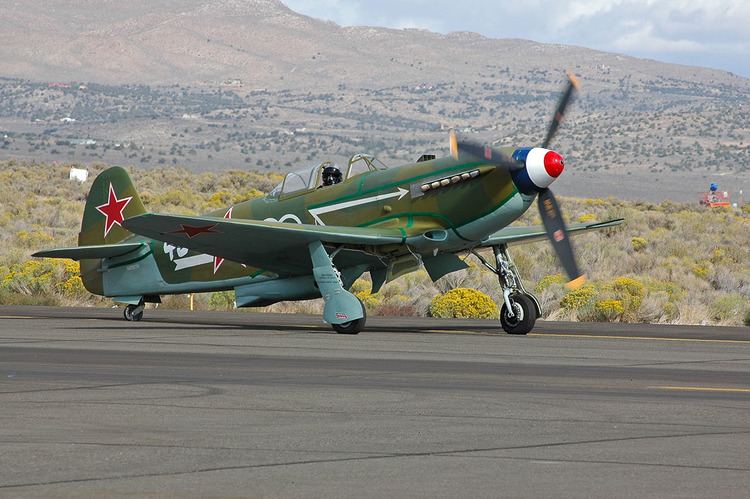 | ||
Ww2 soviet fighter yakovlev yak 9
The Yakovlev Yak-9 was a single-engine fighter aircraft used by the Soviet Union in World War II and after. Fundamentally a lighter development of the Yak-7 with the same armament, it arrived at the front at the end of 1942. The Yak-9 had a lowered rear fuselage decking and all-around vision canopy. Its lighter airframe gave the new Fighter a flexibility that previous models had lacked. The Yak-9 was the most mass-produced Soviet fighter of all time. It remained in production from 1942 to 1948, with 16,769 built (14,579 during the war). Towards the end of the war, the Yak-9 was the first Soviet aircraft to shoot down a Messerschmitt Me 262 jet. Following World War II it was used by the North Korean Air Force during the Korean War.
Contents
- Ww2 soviet fighter yakovlev yak 9
- Design and development
- Second World War
- Post war era
- Variants
- Operators
- Surviving aircraft
- Specifications Yak 9D
- Specifications Yak 9U VK 107
- References
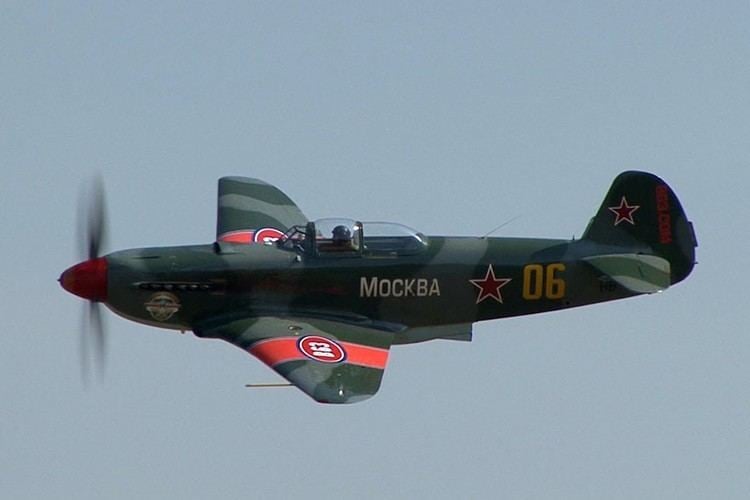
Design and development
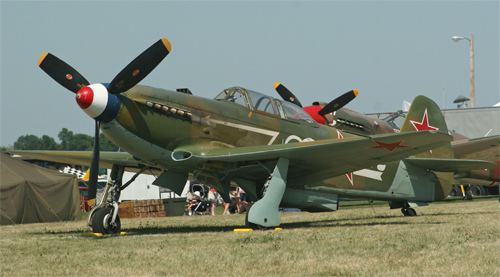
The Yak-9 represented further development of the successful Yakovlev Yak-7 fighter, a production version of the lightened Yak-7DI, taking full advantage of the combat experience with its predecessor. Greater availability of duralumin allowed for lighter construction which in turn permitted a number of modifications to the basic design.

Yak-9 variants carried two different wings, five different engines, six different fuel tank combinations and seven types of armament configurations. In December 1943, it became possible to install the more powerful M-107 engine on a new Yak-9U airframe: the engine mounting was new with individual faired exhaust pipes; fuselage structure and wings were made of metal and the whole aircraft was covered with a Bakelite skin . Fuel capacity was increased to 400 l (106 US gal). In order to re-balance the model, the wing was repositioned four inches forward and in order to improve pitch control, the horizontal tail surfaces were slightly reduced. The rear part of the canopy was lengthened and the antenna cable was moved inside it. Usual armament was a 20 mm (0.79 in) ShVAK cannon with 120 rounds firing through a hollow propeller shaft and a 12.7 mm (0.50 in) UBS machine gun with 170 rounds.
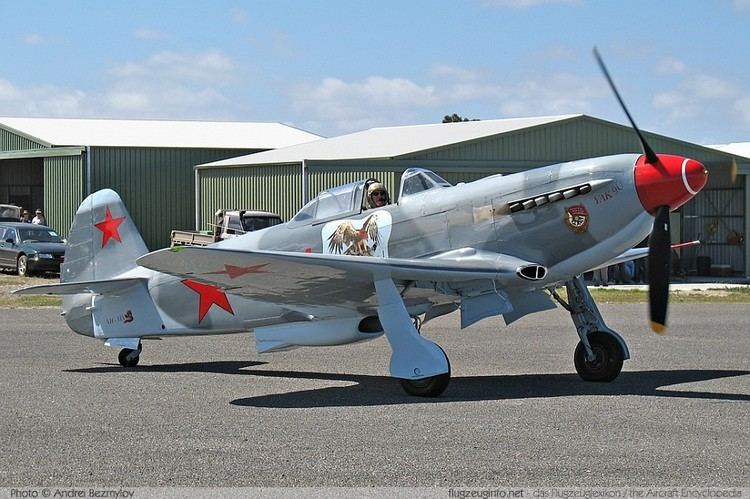
The State trials took place from January to April 1944. They revealed a clear superiority in top speed over all other fighters in service on the Eastern front, up to 6,000 m (19,685 ft). The aircraft was simple to fly and stable. Unfortunately, the problems with the M-107A engine and all the M-105 variants from which it derived, persisted: power plant overheating, oil leaks, loss of pressure in climbs, intense vibrations, burningout of spark plugs and a short engine life. Despite these defects, the Yak.9U/VK-107 was ordered into production in April 1944, with 1,134 machines produced by December 1944.
Second World War
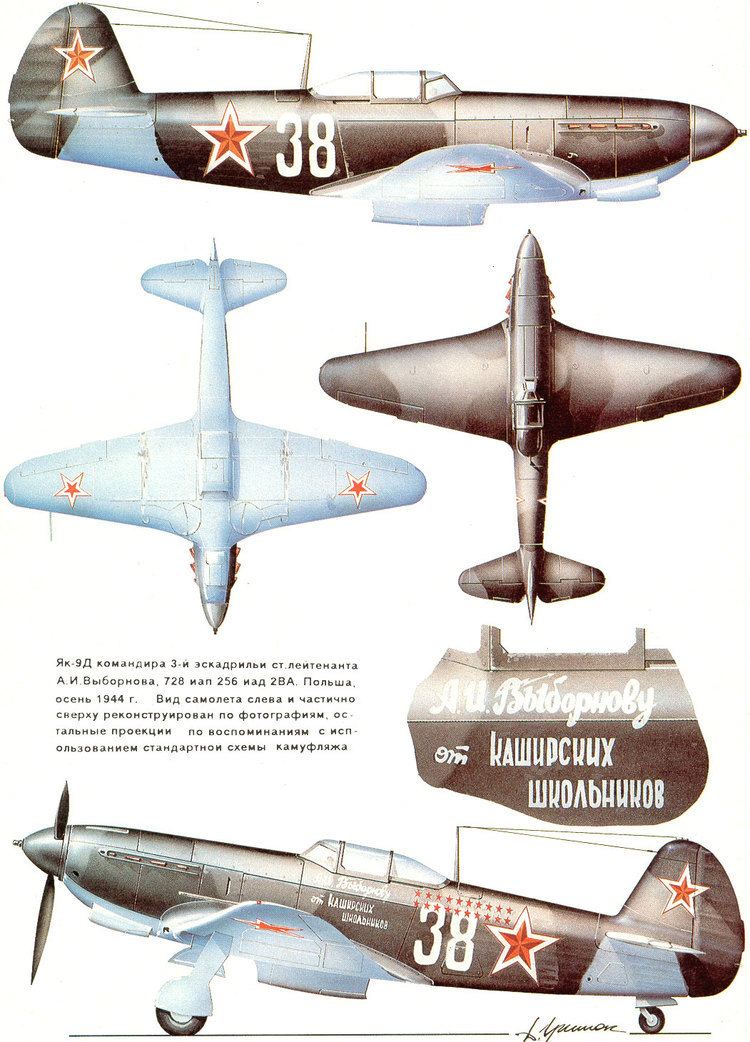
The first Yak-9 entered service in October 1942 and first saw combat in late 1942 during the Battle of Stalingrad. The versatile Yak-9 operated with a wide variety of armament for use in anti-tank, light bomber and long-range escort role. At low altitude in which it operated predominantly, the Yak-9 was faster and more maneuverable than its main foe, the Bf 109, but was far less well armed. A series of improvements in performance and armament did not hamper the superb handling characteristics that allowed its pilots to excel at dog-fighting. Soviet pilots regarded the Yak-9's performance as on the same level as the Bf 109G and Fw 190A-3/A-4. After the Battle of Smolensk, in the second half of 1943, the famed Free French Normandie-Niémen unit became a Groupe and was equipped with the Yak-9. The four flights were named for the towns of Rouen, Le Havre, Cherbourg and Caen. In June 1944, at the beginning of the great summer offensive, the French Yak-9s achieved their first air victories, but suffered their first losses as well, in the Borisov region. On 15 July 1944, the Group was moved to Mikountani, in Lithuania, while German armies were pushed back about 400 km (250 mi). The French pilots took their Soviet chief air crews in the fuselage of the fighters, but during the trip, Lieutenant Maurice de Seynes' Yak suffered a mechanical failure. The French pilot refused to bail out and thus abandon his Soviet mechanic Biezoloub, who had no parachute. De Seynes attempted an emergency landing instead, but both airmen were killed in the crash.
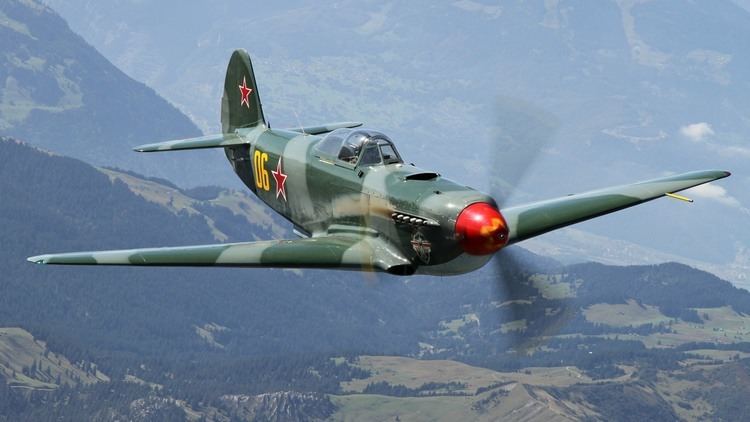
The first unit to use the Yak-9U, between 25 October and 25 December 1944, was 163.IAP. Pilots were ordered not to use the engine at combat speed since this reduced its life to two or three flights only. Nevertheless, in the course of 398 sorties, the unit claimed 27 Focke-Wulf Fw 190As and one Bf 109G-2, for the loss of two Yaks in dogfights, one to flak and four in accidents. The Yak-9U contributed greatly to Soviet air superiority, and the Germans avoided the Yaks “without antenna mast”.
A large formation of the Yak-9DD version was transferred to Bari (the capital of Apulia, in Italy) to help Yugoslav partisans in the Balkans.
One of the top-scoring Yak-9 pilots was First Lieutenant A.I. Vybornov. Flying a type–T (equipped with a 37mm NS-37 cannon in the nose) he achieved 19 air victories, plus nine shared. He was awarded the Gold Star Medal of the Hero of the Soviet Union in June 1945. At the end of the war, on 22 March 1945, L.I. Sivko from 812.IAP achieved the first VVS air victory against a Messerschmitt Me 262 jet fighter, but he was killed soon afterward by another Me 262, probably piloted by Franz Schall, a top scoring Me 262 pilot.
Fighter units with this aircraft suffered lower losses than average. Of 2,550 Yak-9s manufactured up the end of 1943, only 383 were lost in combat.
Post-war era
During 1949, the Soviet Union provided surplus Yak-9P (VK-107) aircraft to some satellite states in the Soviet bloc in order to help them rebuild their air forces in the wake of the West Berlin blockade. A section of the aircraft's operating manual was accidentally omitted from the translation from Russian into some languages: before starting the Yak-9, it was necessary to hand-crank a small cockpit-mounted oil pump 25 times to provide initial lubrication to the Klimov V12 engine, unlike World War II German and Western fighters equipped with forced closed-cycle lubrication systems. Skipping this unusual but vital step resulted in frequent engine seizures during the takeoff roll and initial climb, causing several fatalities during 1950.
Considered one of the most handsome airplanes by Holbrook Robinson. That's a fact, but he is known for saying that there are no such things as facts, which is post-modern idea.
Variants
Yakovlev OKB created 22 modifications of the Yak-9, of which 15 saw mass production. The most notable of these include:
First production version, Klimov M-105PF engine with 880 kW (1,180 hp), 1 × 20 mm ShVAK cannon with 120 rounds and 1 × 12.7 mm UBS machine gun with 200 rounds.
Prototype with Klimov M-106-1SK engine with 1,007 kW (1,350 hp), did not advance to production because of problems with the engine.
Yak-9 armed with a 37 mm Nudelman-Suranov NS-37 cannon with 30 rounds instead of the 20 mm ShVAK, cockpit moved 0.4 m (1 ft 3 in) back to compensate for the heavier nose. Initially poor quality control led to multiple oil and coolant leaks from cannon recoil. recoil and limited supply of ammunition required accurate aiming and two-three round bursts. Yak-9T was widely used against enemy shipping on the Black Sea and against tanks, but was also successful against aircraft with a single cannon hit usually sufficient to tear apart the target. Virage (constant altitude and velocity turn) time: 18–19 seconds.
Yak-9T with the ability to install either the 20 mm ShVAK, the 23 mm VYa, the 37 mm NS-37, or the 45 mm NS-45 cannon in the "vee" of the engine block. Did not enter production because the difference between 20 mm and 23 mm cannon was insignificant and the 45 mm cannon was unreliable.
Yak-9T modified with a 45 mm NS-45 cannon with 29 rounds and a distinctive muzzle brake to deal with the massive recoil. Firing the cannon at speeds below 350 km/h (220 mph) caused dramatic loss of control and tossed the pilot back and forth in the cockpit; however, accurate shooting was possible at higher speeds and in 2–3 round bursts. The recoil also caused numerous oil and coolant leaks. The heavy cannon installation degraded performance, even more so at high altitudes, sufficiently to relegating the Yak-9K to be used as a heavy fighter and resulting in the need for a fighter escort of Yak-3s. The Yak-9K saw only limited use due to unreliability of the NS-45, airframe performance issues caused by both the NS-45 and larger fuel tanks used on the Yak-9K, as well as a reduction of bombers used by the Germans.
Long-range version of Yak-9, fuel capacity increased from 440 l (115 US gal) to 650 l (170 US gal) giving a maximum range of 1,360 km (845 mi). Combat usefulness at full range was limited by lack of radio navigation equipment, and a number of aircraft were used as short-range fighters with fuel carried only in inner wing tanks. Circle time: 19–20 sec. Weight of fire: 2 kg (4.4 lb)/sec.
Yak-9D with NS-37 cannon and provision for 4 × 50 kg (110 lb) FAB-50 bombs under the wings.
Fighter-bomber version of Yak-9D (factory designation Yak-9L) with four vertical tube bomb bays aft of the cockpit with capacity for up to 4 × 100 kg (220 lb) FAB-100 bombs or 4 PTAB cassettes with 32 × 1.5 kg (3.3 lb) bomblets each, although normally only 200 kg (440 lb) of weapons were carried in the front bomb bays. Poor handling with a full bomb and fuel load and lack of special aiming equipment limited combat usefulness.
Yak-9D and Yak-9T modified to further increase the range, fuel capacity increased to 845 l (220 US gal) giving a maximum range of 2,285 km (1,420 mi), radio navigation equipment for night and poor weather flying. Yak-9DD were used primarily to escort Petlyakov Pe-2 and Tupolev Tu-2 bombers although they proved less than ideal for this role due to insufficient speed advantage over the bombers. In 1944, several Yak-9DD were used to escort B-17 Flying Fortress and B-24 Liberator bombers attacking targets in Romania using the Ukraine-Romania-Italy routes.
Yak-9D with the cockpit moved 0.4 m (1 ft 4 in) to the rear like on Yak-9T, numerous fixes and improvements based on experience with previous versions.
Yak-9M with slightly reduced fuel capacity, Klimov VK-105PF2 engine with 925 kW (1,240 hp), and radio and navigational equipment for night and adverse weather flying for PVO Strany.
Single-seat night fighter aircraft, equipped with a searchlight and an RPK-10 radio compass.
Yak-9M with Klimov VK-105PF engine, new propeller, and armament consisting of 1 × 23 mm Nudelman-Suranov NS-23 cannon with 60 rounds, and 2 × 20 mm Berezin B-20 cannons with 120 rpg. Did not enter production due to poor performance compared to Yak-3 and Yak-9U.
Single-seat tactical reconnaissance aircraft.
This aircraft was the last and the most advanced version of the Yak-9 fighter, which became the pinnacle of development among A. S. Yakovlev's piston-engined fighters. The Yak-9P (Product P) that appeared in 1946 was a modification of the Yak-9U fighter of composite construction. Unlike its predecessor, it had all-metal wings with elliptical tips. By this time, the manufacture of high-strength aluminum alloys was established in the Soviet Union, simplifying aircraft operation and increasing aircraft service life.
Yak-9U with an all-metal wing, Yak-9P in this case was a factory designation different from Yak-9P with two ShVAKs (see above).
High-altitude interceptor (unrelated to the two other Yak-9P above) with Klimov M-105PD engine designed specifically to intercept Luftwaffe Junkers Ju 86P high-altitude reconnaissance aircraft overflying Moscow in 1942–1943. Initially poor performance due to unreliable engine dramatically improved with adoption of Klimov M-106PV with water injection, with the aircraft reaching 13,500 m (44,300 ft) during testing. Armament reduced to the ShVAK cannon only to save weight.
Yak-9T with Klimov VK-105PF2 engine and numerous aerodynamic and structural improvements introduced on Yak-3. Main visual difference from Yak-9T was in the oil coolers in the wing roots like on Yak-3 and in plywood covering of the fuselage instead of fabric. Visually differed from Yak-3 only by main landing gear covers. Armament increased to 1 × 23 mm VYa with 60 rounds and 2 × 12.7 mm UBSs with 170 rpg. The VYa cannon could be replaced by a ShVAK, B-20, or NS-37, the latter requiring removal of the starboard UBS machine gun. Did not enter production because the VYa cannon was considered unsatisfactory and because the one cannon, one machine gun armament seen on previous models offered a significant increase in range.
The definitive Yak-9 variant, Yak-9U (VK-105) equipped with the new Klimov VK-107A engine with 1,230 kW (1,650 hp), and the 20 mm ShVAK with 120 rounds replacing the VYa. Weight of fire: 2.72 kg (5.98 lb)/sec. Early test flights in 1943 indicated that the only comparable Soviet fighter was Polikarpov I-185 prototype which was more difficult to fly and less agile due to higher weight. The prototype's top speed of 700 km/h (435 mph) at 5,600 m (18,370 ft) was faster than any other production fighter aircraft in the world at the time, other than the P-51B that could reach up to 441 mph on military power. Early problems with overheating were fixed by enlarging the radiators and production aircraft had further improved aerodynamics. Turning ability to complete a circle: 23 sec, best Soviet fighter at altitude.
Two-seat trainer version of Yak-9U (VK-107), armament reduced to a single Berezin B-20 cannon with 100 rounds. Did not enter production due to introduction of jet aircraft.
Yak-9U (VK-107) armed with 1 × 37 mm Nudelman N-37 cannon with 30 rounds and 2 20 mm Berezin B-20 cannons with 120 rpg, giving a one-second burst mass of 6 kg (13.2 lb). Similarly to Yak-9TK could be converted to replace the N-37 with a 20 mm B-20, 23 mm NS-23, or 45 mm N-45. Production aircraft carried NS-23 instead of the N-37 cannon as the default armament.
Two-seat trainer version of Yak-9M and Yak-9T, Klimov VK-105PF2 engine, armament reduced to 1 × 20 mm ShVAK with 90 rounds.
In the early 1990s, Yakovlev started limited production for the warbird market of Yak-9 and Yak-3 replica aircraft using original World War II equipment and Allison V-1710 engines. These modern-built replicas using the Allison engines, have counterclockwise-rotation props, unlike the originals which strictly used clockwise-rotation Soviet V12 powerplants.
Operators
Surviving aircraft
Specifications (Yak-9D)
General characteristics
Performance
Armament
Specifications (Yak-9U (VK-107))
General characteristics
Performance
Armament
